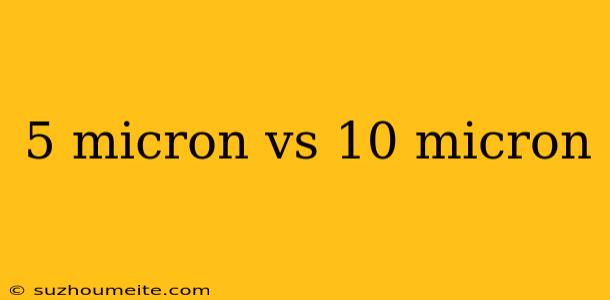5 Micron vs 10 Micron: Understanding the Difference
When it comes to water filtration, the micron rating is a crucial factor to consider. The micron rating determines the size of the particles that can pass through the filter, with smaller microns indicating a more precise filtration. Two common micron ratings found in water filters are 5 micron and 10 micron. But what's the difference between them?
What is a Micron?
Before we dive into the comparison, let's define what a micron is. A micron is a unit of measurement that represents one millionth of a meter. In the context of water filtration, it refers to the size of the pores or holes in the filter medium. The smaller the micron rating, the smaller the pores, and the more precise the filtration.
5 Micron Filter
A 5 micron filter has pores that are 5 microns in size. This means that it can capture particles as small as 5 microns in diameter. To put that into perspective, the human hair is around 70-80 microns thick, so a 5 micron filter can capture particles that are roughly 1/14th the size of a human hair.
10 Micron Filter
A 10 micron filter has pores that are twice as large as those found in a 5 micron filter. This means that it can capture particles that are 10 microns in diameter, which is roughly 1/7th the size of a human hair.
Key Differences
So, what are the key differences between a 5 micron and 10 micron filter?
filtration precision
A 5 micron filter is more precise than a 10 micron filter, capturing smaller particles and providing a cleaner output.
Contaminant removal
A 5 micron filter can remove more contaminants, including sediment, silt, and bacteria, due to its smaller pore size. A 10 micron filter may allow some of these contaminants to pass through.
Flow rate
A 10 micron filter typically has a higher flow rate than a 5 micron filter, as the larger pores allow water to pass through more quickly.
Maintenance
A 5 micron filter may require more frequent maintenance, as it can clog more easily due to its smaller pores.
Which One to Choose?
The choice between a 5 micron and 10 micron filter depends on your specific needs and requirements. If you need a high level of filtration precision and are willing to perform more frequent maintenance, a 5 micron filter may be the better choice. However, if you prioritize a higher flow rate and are comfortable with a slightly lower level of filtration precision, a 10 micron filter may be the way to go.
Conclusion
In conclusion, while both 5 micron and 10 micron filters have their own advantages and disadvantages, the key differences lie in their filtration precision, contaminant removal, flow rate, and maintenance requirements. By understanding these differences, you can make an informed decision about which type of filter is best for your specific needs.
